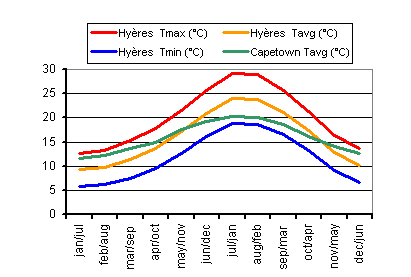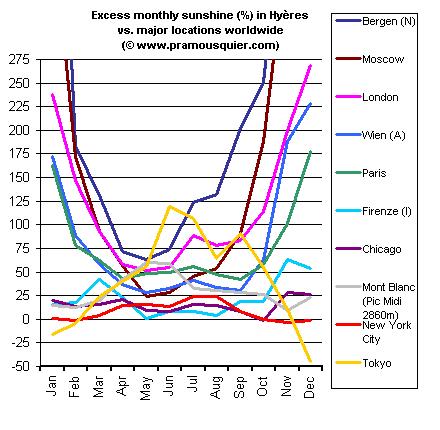Climate in Pramousquier
Though geographically, Pramousquier (43.15°N, 6.45°E) is not the most southern
place in continental France, it sets the record for sunshine and temperature
in this country with nearly 2900 hours of sun per year, and an average annual
temperature of 15.9°C.
One may wonder how this can be, at a latitude identical to that of Vladivostok
(Russia), Milwaukee (WI-USA), Hobart (Tasmania), Sapporo (Japan), Concord (MA-USA)
or Trelew (Argentina). Pramousquier is located quite a bit north, rather than
south, of colder places like Tokyo (latitude 35.6°N - avg. temp. 14.7 °C), New
York City (lat. 40.7°N - avg. temp. 12.6°C) or Chicago (lat. 41.9°N - avg. temp.
10.5°C).
 We
have searched through all available meteorological and climatic data (30 years
averages 1961-1990)) of cities and places around the world in order to find
the most similar climate to Pramousquier/Hyères County. The result seems surprising
at a first glace, but it is not really unexpected when we look at the vegetation
of the garden or of the Rayolgardens
just at the east of this place: In Capetown, South Africa, average annual temperature
is exactly the same, 15.9°C, average monthly temperatures are in the same range
(seasons are adjusted in the chart on the right), and sunshine is nearly the
same (5% difference in favour of Capetown) as in Pramousquier. However, Capetown
(lat. 33.9°S) is almost 10° closer to the equator than Pramousquier, and just
like Pramousquier, Capetown benefits from an even stronger climatic influence
from the sea.
We
have searched through all available meteorological and climatic data (30 years
averages 1961-1990)) of cities and places around the world in order to find
the most similar climate to Pramousquier/Hyères County. The result seems surprising
at a first glace, but it is not really unexpected when we look at the vegetation
of the garden or of the Rayolgardens
just at the east of this place: In Capetown, South Africa, average annual temperature
is exactly the same, 15.9°C, average monthly temperatures are in the same range
(seasons are adjusted in the chart on the right), and sunshine is nearly the
same (5% difference in favour of Capetown) as in Pramousquier. However, Capetown
(lat. 33.9°S) is almost 10° closer to the equator than Pramousquier, and just
like Pramousquier, Capetown benefits from an even stronger climatic influence
from the sea.
The wonderful climate in Pramousquier is due to the conjunction of 4 major
influences :
1) the major influence of the Atlantic Gulf Stream that warms up entire Western
Europe;
2) the Mediterranean Sea with its marine climate and its proper circular stream
that warms up the southern coast of France. This circular stream (nicely visible
from space near the Rhone delta), counter
clockwise enlacing the entire Mediterranean Sea at a pace of one circle per
year, flows north from the eastern shores of the African Mediterranean to reach
the western Italian coast, the Genoa Gulf and then the Riviera/Côte d'Azur;
3) the Mistral wind clears the sky from any cloud trying to approach the Rhone
valley;
4) the Maures mountain range (the most southern outlays of the Alps) protect
the coastline from clouds from the north and the west.

 The
conjunction of these influences reaches its highest
climatic power right in Hyères County. Even sunny Nice and Cannes, with 2694
hours per year of sunshine, though doing better than Monaco (2583 h/yr), cannot
equal Marseille (2835h/yr) or Hyères (2899 h/yr) (chart
on the left). The same is true regarding temperatures (chart
on the right).
The
conjunction of these influences reaches its highest
climatic power right in Hyères County. Even sunny Nice and Cannes, with 2694
hours per year of sunshine, though doing better than Monaco (2583 h/yr), cannot
equal Marseille (2835h/yr) or Hyères (2899 h/yr) (chart
on the left). The same is true regarding temperatures (chart
on the right).

 On
a world scale, there are not so many places out of the
desert that do better than Pramousquier/Hyères regarding sunshine (chart
on the left) - all of them are quite a bit closer to the equator. Still,
no need to use an air conditioner here : temperature, though the highest in
France when taken at its monthly or annual averages (chart),
is never excessively hot in summer. Neither obviously could it be cold in winter
(chart).
On a world scale, many places are warmer (chart
on the right), though none at this latitude, but can they do without air
conditioning in summertime?
On
a world scale, there are not so many places out of the
desert that do better than Pramousquier/Hyères regarding sunshine (chart
on the left) - all of them are quite a bit closer to the equator. Still,
no need to use an air conditioner here : temperature, though the highest in
France when taken at its monthly or annual averages (chart),
is never excessively hot in summer. Neither obviously could it be cold in winter
(chart).
On a world scale, many places are warmer (chart
on the right), though none at this latitude, but can they do without air
conditioning in summertime?
There is a huge demand in Europe for getting a place to
stay in our region during summertime (with place for "only" 30 million
people on the entire Côte including the less sunny north-eastern part near Cannes
and Nice...).  However, insiders and owners prefer the 3 other seasons. This is thought to
be due to having more space to live, and not being stuck in traffic jams during
these seasons. But are these the only reasons? Let's take a look once more at
our climatic data. Not only is it a lot warmer throughout the year than anywhere
else in France (especially in winter), also the "sunshine bonus" (percentage
of extra sun in Hyères when compared to other places in France) is much greater
during the fall and winter than during summer and spring (chart
on the right), except for the south-western Mediterranean coast of France
where this sunshine bonus is higher during summer.
However, insiders and owners prefer the 3 other seasons. This is thought to
be due to having more space to live, and not being stuck in traffic jams during
these seasons. But are these the only reasons? Let's take a look once more at
our climatic data. Not only is it a lot warmer throughout the year than anywhere
else in France (especially in winter), also the "sunshine bonus" (percentage
of extra sun in Hyères when compared to other places in France) is much greater
during the fall and winter than during summer and spring (chart
on the right), except for the south-western Mediterranean coast of France
where this sunshine bonus is higher during summer.
All data are mean values over 30 years (1961-1990). New data over the time
span 1991 to 2000 are starting to be published but they are not yet complete
enough to be presented here. The global tendency in France is toward higher
temperatures and 10% less sunshine, except on the Mediterranean seashore. Therefore
the data presented herein are even more striking at the present time than they
were during the period 1961-1990.
Taking the same calculation of sunshine bonus on a world scale, we find 3 patterns
in the northern hemisphere (click on the chart below if you wish to see a more
detailed
chart including all data table):
1) a U-shaped pattern (London, Paris, Vienna, Moscow) with twice as much sun
or even more in Hyères County than in these cities during the cold winter months;
this pattern is found in cities generally located further north ;
2) a flat pattern with more sunshine in Hyères County throughout the year (Chicago);
this pattern is found in cities with continental climate and located on a more
southern latitude ;
3) an inverted U-shaped pattern, found in east-coast cities on more southern
latitudes (NYC, Tokyo), and also in high mountain regions whenever they are
above the clouds in wintertime (Mont Blanc - Pic du Midi in France, Zugspitze
in Germany). Compared with Tokyo and to a lesser extent NYC, the sunshine bonus
in Hyères County is quite clear in spring, in summer, and in early fall. Versus
Tokyo, it remains above 50% from May throughout October, and even above 100%
in June and July, but it turns negative during the winter. This means that there
is more sun in December and January in Tokyo or NYC than in Hyères County/ Pramousquier,
due to the southern latitude of these east-coast cities.
These patterns show that except when living in a few east-coast cities at latitudes
lower than 43°N, or in very high altitude mountain regions (>2500m), the
highest sunshine bonus when coming to our county from the northern hemisphere
is during the seasons of fall, winter, and early spring. This is exactly what
owners and insiders do!
 We
have searched through all available meteorological and climatic data (30 years
averages 1961-1990)) of cities and places around the world in order to find
the most similar climate to Pramousquier/Hyères County. The result seems surprising
at a first glace, but it is not really unexpected when we look at the vegetation
of the garden or of the Rayolgardens
just at the east of this place: In Capetown, South Africa, average annual temperature
is exactly the same, 15.9°C, average monthly temperatures are in the same range
(seasons are adjusted in the chart on the right), and sunshine is nearly the
same (5% difference in favour of Capetown) as in Pramousquier. However, Capetown
(lat. 33.9°S) is almost 10° closer to the equator than Pramousquier, and just
like Pramousquier, Capetown benefits from an even stronger climatic influence
from the sea.
We
have searched through all available meteorological and climatic data (30 years
averages 1961-1990)) of cities and places around the world in order to find
the most similar climate to Pramousquier/Hyères County. The result seems surprising
at a first glace, but it is not really unexpected when we look at the vegetation
of the garden or of the Rayolgardens
just at the east of this place: In Capetown, South Africa, average annual temperature
is exactly the same, 15.9°C, average monthly temperatures are in the same range
(seasons are adjusted in the chart on the right), and sunshine is nearly the
same (5% difference in favour of Capetown) as in Pramousquier. However, Capetown
(lat. 33.9°S) is almost 10° closer to the equator than Pramousquier, and just
like Pramousquier, Capetown benefits from an even stronger climatic influence
from the sea.




